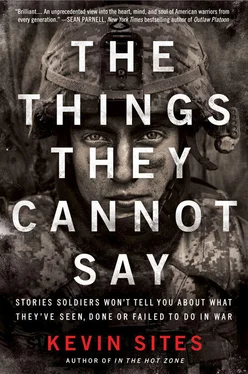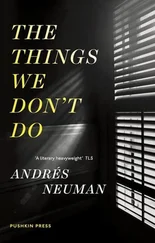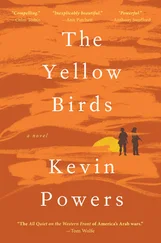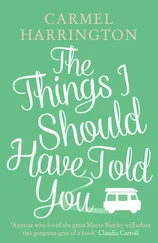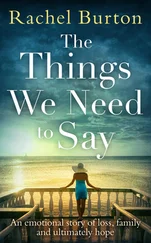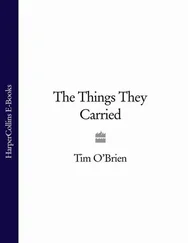If there was anything that underscored the fact that I needed therapy to deal with the toxic blowback that became my life in the aftermath of my war experiences, it was this: during a holiday break from my fellowship, while doing coke with an old friend, we turned the razor we used to chop the lines onto our own bodies. I pulled it along my lower back, the blood immediately bleeding up from the fissure I had just created below and parallel to my waistline, where it would be hidden from all but those who knew me most intimately. My friend did the same. Then I took the razor again and this time sank it in above my right hip deeply enough to carve a long asterisk that, in time, raised into a permanent dark-pink keloid. I’m not sure what statement I was making, but it may have had something to do with the desperation of feeling like an asterisk to history.
Cutting didn’t become a regular practice for me. It was more of a novelty than a persistent desire, simply another chance to physically punish myself for letting a man die.
What was almost comically incomprehensible to me after the realization of what I had done in Fallujah was that my dreams before I began going to war with great frequency were mostly filled with the idea of saving people rather than letting them die. I remember a specific dream I had when I lived in Washington, DC, in which I dived into the frozen Potomac after a jet crashed in the river (likely spurred by the memory of an Air Florida plane crashing into the river in 1982 and the bystander who jumped into the icy water in an attempt to rescue someone; seventy-eight people died). In my dream I took a cable from a construction crane on the riverbank and wrapped it around my waist, swam to the plane, looped it around the fuselage and then used the crane to winch the plane and its passengers to safety back on shore… No big thing.
But when the actual opportunity to save someone was right in front of me, a man begging for his life, I couldn’t see it. I was shocked and confused by the killing I had just witnessed and videotaped. I couldn’t process the fact that the person in front of me might be the next victim. If there was any doubt that the shooting I captured on video was unjustified, it disappeared completely with Taleb Salem Nidal. Wounded and obviously unarmed, he was killed in a horrible and cowardly way, almost two dozen bullets stitching his back, likely as he saw the intent of his killers and tried in vain to crawl away. While I can never forgive myself for this, what I did realize was that I had been aggressively trying to kill myself, either in combat or through the attrition of alcohol, drugs and dangerous situations, in atonement.
If it accomplished anything, the cutting proved to me how far off the grid I had fallen. In its aftermath, I finally succumbed to therapy, but only because of a confluence of circumstances. A friend, despite being treated shoddily by me, helped find me a suitable therapist, and the therapist was willing to treat me for a fraction of his normal fee. But perhaps most importantly, I felt I had a reason to go. While still at Harvard I had made a trip back to Los Angeles for some interviews for this book. While there, I contacted Anita. We hiked Temescal Canyon again and then I made her dinner. On the plane back to Boston, I wrote her a five-page e-mail, explaining how from the very first day that I met her at Joshua Tree she had inspired me with her courage and willingness to face her greatest fears. Then I really piled it on like a lovesick schoolboy, using our climbing experience as the metaphor for how I would always be there to protect her from a fall. It took her three days to respond. I began to think I might’ve overshot a little. I wondered if I had not only lost the potential of a romantic relationship but killed the friendship as well. After some lengthy “negotiations” and a number of cross-country visits we began a relationship that resulted in our getting an apartment together in Los Angeles. But it would not be just the two of us. Anita’s ten-year-old daughter would also be living with us, as well as Anita’s sister (who was going through a messy divorce) and her six-year-old daughter. Overnight, I became a parent. The car wreck of post-traumatic stress and drug and alcohol abuse was no longer an option, nor would it be tolerated by Anita.
For two months, I embarked on a life I had never experienced before; each morning I woke up and made breakfast for the girls and then drove them to school. I helped them with their homework, played board games and card games with them, watched the Disney Channel and listened to them speak about the virtues of the Jonas Brothers and Justin Bieber. At night I would make them dinner and when Anita got home from work, we sat down at the table together as a family, one to which I was joined not by blood but by belief.
Of all that I had accomplished, my time in this family, I quickly realized, was an irreplaceable gift, the opportunity and motivation to be a better man. But the anger, guilt and self-destruction did not simply disappear with my new life and responsibilities. I had a difficult path ahead and many months before I could begin to let go of the past and fully embrace hope.
Shortly after the invasion of Iraq in the spring of 2003 and one year before the mosque shootings, I was briefly captured by Saddam’s Fedayeen militia along with a CNN colleague, our bodyguard and an interpreter outside Tikrit. It’s strange to me, because while I was scared shitless at the time, in the subsequent years I rarely thought about the capture and didn’t think it had contributed to my erratic postwar state of mind. But there was a place, I discovered through my eventual therapy, where it did intersect, a place I avoided, until I could no longer contain the toxic mess of my life.
This is the image that I’ve tried to forget: I’m on my knees and I’m pleading for my life. As I was taught in a hostile-environment course for journalists, which I was compelled to take by my employer long after I started covering wars for a living, I’m trying to make eye contact with one of my captors. I’m trying to make him see me as a fellow human being rather than an animal, a threat, an impediment or even leverage. My hands are clasped one on top of the other and I pump them in front of me as if I might be agitating a bottle of champagne after winning the Tour de France or Indy 500—but this, I hope instead, he will recognize as the international symbol of someone begging for his life. In case he still doesn’t understand, in perhaps an ill-advised gesture, I draw one hand across my throat like a blade and at the same time say in English, “No. No.”
Sitting in my therapist’s office six years later, I wondered why I had shut out so completely this specific detail of the memory. Was I ashamed of what I had done? Was I afraid to remember what it felt like to be completely powerless and without any control? Or was it, as my therapist asked me to consider, a correlation of two images too disturbing for me to hold together in my mind: the image of myself pleading with my captors for my life compared with the image of Taleb Salem Nidal inside that Fallujah mosque pleading with me to save his? While I got out of my predicament alive, thanks to the negotiations of Tofiq Abdol, my Kurdish interpreter, Nidal was not fortunate enough to have someone like that to champion his cause.
Considering his career choice, Mark Sadoff was aptly and whimsically named. He had treated everyone from husbands and wives trying to comprehend their loveless relationships to Central American victims of torture. He had been studying an emerging form of therapy known as EMDR, eye movement desensitization and reprocessing therapy (the same therapy used in Michael Ayala’s case). With EMDR the therapist attempts to re-create the rapid eye movement of sleep by having the patient follow the therapist’s finger moving back and forth in front of his eyes like a metronome. At the same time the therapist prompts the patient to talk about the incident affecting them, trying to change its negative orbit into something more positive. In my situation, Dr. Sadoff asked me if I purposely wanted Taleb Salem Nidal to die or if my actions were accidental, rather than intentional. If I could have prevented his death, if I knew what would’ve happened to him when I left the room, would I have acted differently? Of course I would have stayed, I said, I would have taken him out of the mosque to somewhere he might be safe, rather than leaving him alone. It was Dr. Sadoff’s effort to get my guilt-addled brain to understand that Taleb Salem Nidal hadn’t registered as a victim to me, as someone who needed saving. The person I was trying to save, by exposing the crime, was the one who had already been killed on videotape in front of me. He helped me to understand that it was a mistake, not malice. My intentions were good, I just hadn’t thought the situation through clearly, which was understandable considering what I had just witnessed. Through our discussions he also helped me to see that difficult but ultimately critical connection between my capture outside Tikrit and the murder of Taleb Salem Nidal. With no interpreter, no Tofiq, as I had had during my capture, to translate for him, Nidal would die because I did not understand, as I should have, that I needed to walk him out of that mosque under my protection. I didn’t save anyone, as I did in my dream; I let the plane sink to the bottom of the Potomac. I did nothing. But I had to find a way to forgive myself, or in a misguided search for equal justice, I would end up killing myself in exchange.
Читать дальше
